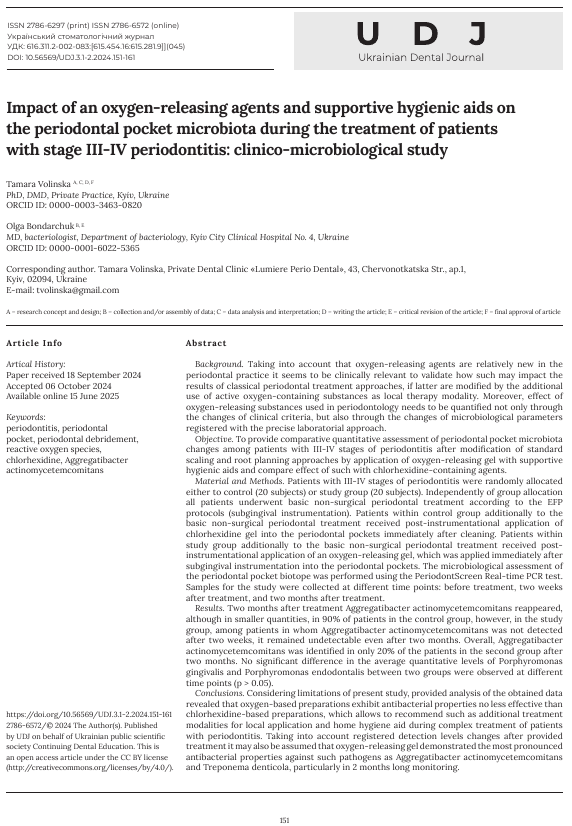Вплив кисневмісних речовин та підтримуючих гігієнічних засобів на мікробіоту пародонтальної кишені під час лікування пацієнтів з пародонтитом III-IV стадії: клініко-мікробіологічне дослідження
DOI:
https://doi.org/10.56569/UDJ.3.1-2.2024.151-161Ключові слова:
пародонтит, пародонтальна кишеня, санація пародонту, активні форми кисню, хлоргексидин, Aggregatibacter actinomycetemcomitansАнотація
Вступ. Враховуючи, що кисневмісні речовини є відносно новими в пародонтологічній практиці, клінічно актуальним видається обґрунтування того, як вони можуть впливати на результати класичних підходів до лікування пародонту, якщо останні модифікуються додатковим використанням активних кисневмісних речовин, як методу місцевої терапії. Більше того, ефект кисневмісних речовин, що використовуються в пародонтології, необхідно кількісно оцінювати не лише через зміни клінічних критеріїв, але й через зміни мікробіологічних параметрів, зареєстрованих за допомогою точного лабораторного підходу.
Мета. Систематизувати та описати основні дані щодо використання віртуального штучного інтелекту для різноманітних ендодонтичних клінічних цілей.
Матеріали та методи. Цільовий пошук літератури здійснювався в базах даних Національного центру біотехнологічної інформації за допомогою попередньо визначеного алгоритму Медичних предметних рубрик (Mesh-terms). Під час аналізу контенту з кожної публікації було вибрано наступні дані: аспекти діагностики та планування ендодонтичного лікування, для яких можна застосувати методи ШІ; рівні точності, зареєстровані для моделей ШІ, які використовуються для різних ендодонтичних цілей; обмеження використання ШІ в ендодонтичній практиці.
Результати.Функції штучного інтелекту можна використовувати в ендодонтичній практиці з наступних підстав: аналіз морфології кореневого каналу, ідентифікація переломів кореня, верифікація періапікальних уражень, оцінка робочої довжини кореневого каналу, планування лікування кореневого каналу, прогнозування розвитку болю в період після лікування, прогнозування успішності ендодонтичних втручань. Найбільш поширеними методами штучного інтелекту для різних цілей ендодонтичної діагностики та планування лікування були такі: згорткова нейронна мережа, мережа штучних нейронів, аргументація на основі випадків, глибинне навчання, машинне навчання, нейро-нечітка система виводу, ймовірнісна нейронна мережа.
Висновки. Основна перевага використання моделей штучного інтелекту в ендодонтичній практиці пов’язана з підвищенням діагностичної протягом меншого часу, необхідного для аналізу рентгенівських зображень та аналізу клінічних даних. Застосування штучного інтелекту для виявлення апікального отвору та визначення робочої довжини демонструє значно вищий рівень точності порівняно з продуктивністю ШІ для інших клінічно пов’язаних цілей в ендодонтії.
Заява про конфлікт інтересів
Автори не мають потенційного конфлікту інтересів, який може вплинути на рішення про публікацію цієї статті.
Заява про фінансування
Не було отримано жодного фінансування для допомоги в підготовці та проведенні цього дослідження, а також у написанні цієї статті.
Посилання
1. James P, Worthington HV, Parnell C, Harding M, Lamont T, Cheung A, Whelton H, Riley P. Chlorhexidine mouthrinse as an adjunctive treatment for gingival health. Cochrane Database Syst Rev. 2017;2017(3):CD008676. doi: https://doi.org/10.1002/14651858.CD008676.pub2
2. Retamal-Valdes B, Soares GM, Stewart B, Figueiredo LC, Faveri M, Miller S, Zhang YP, Feres M. Effectiveness of a pre-procedural mouthwash in reducing bacteria in dental aerosols: randomized clinical trial. Braz Oral Res. 2017;31(0):e21. doi: https://doi.org/10.1590/1807-3107BOR-2017.vol31.0021
3. Jones CG. Chlorhexidine: is it still the gold standard?. Periodontol 2000. 1997;15:55-62. doi: https://doi.org/10.1111/j.1600-0757.1997.tb00105.x
4. Ambrogi V, Pietrella D, Nocchetti M, Casagrande S, Moretti V, De Marco S, Ricci M. Montmorillonite–chitosan–chlorhexidine composite films with antibiofilm activity and improved cytotoxicity for wound dressing. J Colloid Interface Sci. 2017;491:265-72. doi: https://doi.org/10.1016/j.jcis.2016.12.058
5. Stewart B, Shibli JA, Araujo M, Figueiredo LC, Panagakos F, Matarazzo F, Mairink R, Onuma T, Faveri M, Retamal‐Valdes B, Feres M. Effects of a toothpaste containing 0.3% triclosan on periodontal parameters of subjects enrolled in a regular maintenance program: A secondary analysis of a 2‐year randomized clinical trial. J Periodontol. 2020;91(5):596-605. doi: https://doi.org/10.1002/JPER.18-050
6. Costa X, Laguna E, Herrera D, Serrano J, Alonso B, Sanz M. Efficacy of a new mouth rinse formulation based on 0.07% cetylpyridinium chloride in the control of plaque and gingivitis: a 6‐month randomized clinical trial. J Clin Periodontol. 2013;40(11):1007-15. doi: https://doi.org/10.1111/jcpe.12158
7. Botushanov PI, Grigorov GI, Aleksandrov GA. A clinical study of a silicate toothpaste with extract from propolis. Folia Med. 2001;43(1-2):28-30
8. Pradeep AR, Agarwal E, Naik SB. Clinical and microbiologic effects of commercially available dentifrice containing aloe vera: a randomized controlled clinical trial. J Periodontol. 2012;83(6):797-804. doi: https://doi.org/10.1902/jop.2011.110371
9. Hammer KA, Carson CF, Riley TV. Influence of organic matter, cations and surfactants on the antimicrobial activity of Melaleuca alternifolia (tea tree) oil in vitro. J Appl Microbiol. 1999;86(3):446-52. doi: https://doi.org/10.1046/j.1365-2672.1999.00684.x
10. Swamy MK, Akhtar MS, Sinniah UR. Antimicrobial properties of plant essential oils against human pathogens and their mode of action: an updated review. Evid Based Complement Alternat Med. 2016;2016(1):3012462. doi: https://doi.org/10.1155/2016/3012462
11. Carson CF, Hammer KA, Riley TV. Melaleuca alternifolia (tea tree) oil: a review of antimicrobial and other medicinal properties. Clinl Microbiol Rev. 2006;19(1):50-62. doi: https://doi.org/10.1128/CMR.19.1.50-62.2006
12. Cunha EJ, Auersvald CM, Deliberador TM, Gonzaga CC, Esteban Florez FL, Correr GM, Storrer CL. Effects of active oxygen toothpaste in supragingival biofilm reduction: a randomized controlled clinical trial. Int J Dent. 2019;2019(1):3938214. doi: https://doi.org/10.1155/2019/3938214
13. Serrano J, Escribano M, Roldan S, Martin C, Herrera D. Efficacy of adjunctive anti‐plaque chemical agents in managing gingivitis: a systematic review and meta‐analysis. J Clin Periodontol. 2015;42:S106-38. doi: https://doi.org/10.1111/jcpe.12331
14. Dalton SJ, Whiting CV, Bailey JR, Mitchell DC, Tarlton JF. Mechanisms of chronic skin ulceration linking lactate, transforming growth factor-β, vascular endothelial growth factor, collagen remodeling, collagen stability, and defective angiogenesis. J Invest Dermatol. 2007;127(4):958-68. doi: https://doi.org/10.1038/sj.jid.5700651
15. Deliberador TM, Weiss SG, Rychuv F, Cordeiro G, Ten Cate MC, Leonardi L, Brancher JA, Scariot R. Comparative analysis in vitro of the application of blue® m oral gel versus chlorhexidine on Porphyromonas gingivalis: A pilot study. Adv Microbiol. 2020;10(04):194. doi: https://doi.org/10.4236/aim.2020.104015
16. Koul A, Kabra R, Chopra R, Sharma N, Sekhar V. Comparative evaluation of oxygen releasing formula (Blue-M Gel®) and chlorhexidine gel as an adjunct with scaling and root planing in the management of patients with chronic periodontitis–A clinico-microbiological study. J Dent Spec. 2023;7(2):111-7. doi: https://doi.org/10.18231/j.jds.2019.026
17. Juliana H, Tarek S. Comparative study of the effect of BlueM active oxygen gel and coe-pack dressing on postoperative surgical depigmentation healing. Saudi Dent J. 2022;34(4):328-34. doi: https://doi.org/10.1016/j.sdentj.2022.04.005
18. Alayadi H, Talakey A, Aldulaijan H, Shaheen MY. The Impact of a Topical Oxygen-Releasing Gel (blue® m) on Deep Periodontal Pockets: A Case Report. Medicina. 2024;60(9):1527. doi: https://doi.org/10.3390/medicina60091527
19. Singh A, Vasudevan S, Palle AR, Atchuta A, Bhadauriya S. Comparative evaluation of scaling and root planing with and without oxygen-releasing gel in the treatment of chronic periodontitis: A split-mouth study. J Contemp Dent Pract. 2024;25(5):445-52. doi: https://doi.org/10.5005/jp-journals-10024-3689
20. Kumar M, Meher B, Mishra L, Panda S, Sokolowski K, Lapinska B. Evaluation of Blue® m Mouthwash vs. Chlorhexidine Mouthwash in Patients with Gingivitis—A Pilot Study. Appl Sci. 2024;14(24):11862. doi: https://doi.org/10.3390/app142411862
21. Haffajee AD, Cugini MA, Dibart S, Smith C, Kent Jr RL, Socransky SS. The effect of SRP on the clinical and microbiological parameters of periodontal diseases. J Clin Periodontol. 1997;24(5):324-34. doi: https://doi.org/10.1111/j.1600-051x.1997.tb00765.x.
22. Bonito AJ, Lux L, Lohr KN. Impact of local adjuncts to scaling and root planing in periodontal disease therapy: a systematic review. J Periodontol. 2005;76(8):1227-36. doi: https://doi.org/10.1902/jop.2005.76.8.1227.
23. Cobb CM. Clinical significance of non-surgical periodontal therapy: an evidence-based perspective of scaling and root planing. J Clin Periodontol. 2002;29:6-16.
24. Sanz M, Herrera D, Kebschull M, Chapple I, Jepsen S, Berglundh T, Sculean A, Tonetti MS, EFP Workshop Participants and Methodological Consultants, Merete Aass A, Aimetti M. Treatment of stage I–III periodontitis—The EFP S3 level clinical practice guideline. J Clin Periodontol. 2020;47:4-60. doi: https://doi.org/10.1111/jcpe.13290
25. Herrera D, Sanz M, Kebschull M, Jepsen S, Sculean A, Berglundh T, Papapanou PN, Chapple I, Tonetti MS, EFP Workshop Participants and Methodological Consultant, Aimetti M. Treatment of stage IV periodontitis: the EFP S3 level clinical practice guideline. J Clin Periodontol. 2022;49:4-71. doi: https://doi.org/10.1111/jcpe.13639
26. Kuret S, Kalajzic N, Ruzdjak M, Grahovac B, Jezina Buselic MA, Sardelić S, Delic A, Susak L, Sutlovic D. Real-Time PCR Method as Diagnostic Tool for Detection of Periodontal Pathogens in Patients with Periodontitis. Int J Mol Sci. 2024;25(10):5097. doi: https://doi.org/10.3390/ijms25105097
27. Nastych O, Goncharuk-Khomyn M, Foros A, Cavalcanti A, Yavuz I, Tsaryk V. Comparison of bacterial load parameters in subgingival plaque during peri-implantitis and periodontitis using the RT-PCR method. Acta Stomatol Croat. 2020;54(1):32-43. doi: https://doi.org/10.15644/asc54/1/4
28. Boutaga K, Van Winkelhoff AJ, Vandenbroucke‐Grauls CM, Savelkoul PH. The additional value of real‐time PCR in the quantitative detection of periodontal pathogens. J Clin Periodontol. 2006;33(6):427-33. doi: https://doi.org/10.1111/j.1600-051X.2006.00925.x
29. Greenstein G. Local drug delivery in the treatment of periodontal diseases: assessing the clinical significance of the results. J Periodontol. 2006;77(4):565-78. doi: https://doi.org/10.1902/jop.2006.050140
30. Kalsi R, Vandana KL, Prakash S. Effect of local drug delivery in chronic periodontitis patients: A meta-analysis. J Indian Soc Periodontol. 2011;15(4):304-9. doi: https://doi.org/10.4103/0972-124X.92559
31. Deus FP, Ouanounou A. Chlorhexidine in dentistry: pharmacology, uses, and adverse effects. Int Dent J. 2022;72(3):269-77. doi: https://doi.org/10.1016/j.identj.2022.01.005
32. Niveda R, Kaarthikeyan G. Effect of oxygen releasing oral gel compared to chlorhexidine gel in the treatment of periodontitis. J Pharm Res Int. 2020;32:75-82. doi: https://doi.org/10.9734/jpri/2020/v32i1930711
33. Basudan AM, Abas I, Shaheen MY, Alghamdi HS. Effectiveness of Topical Oxygen Therapy in Gingivitis and Periodontitis: Clinical Case Reports and Review of the Literature. J Clin Med. 2024;13(5):1451. doi: https://doi.org/10.3390/jcm13051451
34. Shaheen MY, Abas I, Basudan AM, Alghamdi HS. Local Oxygen-Based Therapy (blue® m) for Treatment of Peri-Implant Disease: Clinical Case Presentation and Review of Literature about Conventional Local Adjunct Therapies. Medicina. 2024 8;60(3):447. doi: https://doi.org/10.3390/medicina60030447
35. Garcia VG, Miessi DM, da Rocha TE, Gomes NA, Rodrigues JV, Ervolino E, de Freitas RM, Wainwright M, de Molon RS, Theodoro LH. Shedding Light on the Therapeutic Efficiency of Oxygen-Releasing Gel and Photodynamic Therapy as Adjuvants in the Treatment of Experimental Periodontitis. Photobiomodul Photomed Laser Surg. 2025;43(4):159-72. doi: https://doi.org/10.1089/photob.2024.0083
36. Bali S, Bhargava A, Arora S, Aggarwal P, Nautiyal A, Singhal D. Oxygen-releasing Gel vs 0.2% Chlorhexidine Gel as an Adjuvant to Scaling and Root Planing: A Randomized Controlled Trial. World J Dent. 2022;13(S2):S220-4. doi: https://doi.org/10.5005/jp-journals-10015-2137
37. Nedumaran N, Rajasekar A. Clinical and Biochemical Effects of Antioxidant Gel as a Local Drug Delivery Agent in Stage II Grade A Periodontitis Patients: A Prospective Clinical Study. Cureus. 2024;16(6):e61707. doi: https://doi.org/10.7759/cureus.61707
38. Agarwal S, Bali S, Aggarwal P, Garg A, Nautiyal A, Sharma M. Evaluation of the Efficacy of Oxygen-releasing Gel as an Adjunct to Scaling and Root Planing in Chronic Periodontitis: A Split-mouth Randomized Controlled Trial. J Int Clin Dent Res Organ. 2024;16(2):157-62. doi: https://doi.org/10.4103/jicdro.jicdro_70_23
39. Agarwal R, Kamble PS, Mangalekar SB, Nayak Y, Sawant P, Chatterjee A. A comparative evaluation of efficacy of oxygen releasing formula gel, chlorhexidine gel and scaling and root planing alone in the management of chronic periodontitis–A clinico-microbiological study. Eur Chem Bull. 2023; 12(Si6):4520 – 4536
40. Shibli JA, Rocha TF, Coelho F, de Oliveira Capote TS, Saska S, Melo MA, Pingueiro JM, de Faveri M, Bueno-Silva B. Metabolic activity of hydro-carbon-oxo-borate on a multispecies subgingival periodontal biofilm: a short communication. Clin Oral Investig. 2021;25:5945-53. doi: https://doi.org/10.1007/s00784-021-03900-0

Завантаження
Опубліковано
Номер
Розділ
Категорії
Ліцензія
Авторське право (c) 2024 The Author(s)

Ця робота ліцензується відповідно до ліцензії Creative Commons Attribution 4.0 International License.








